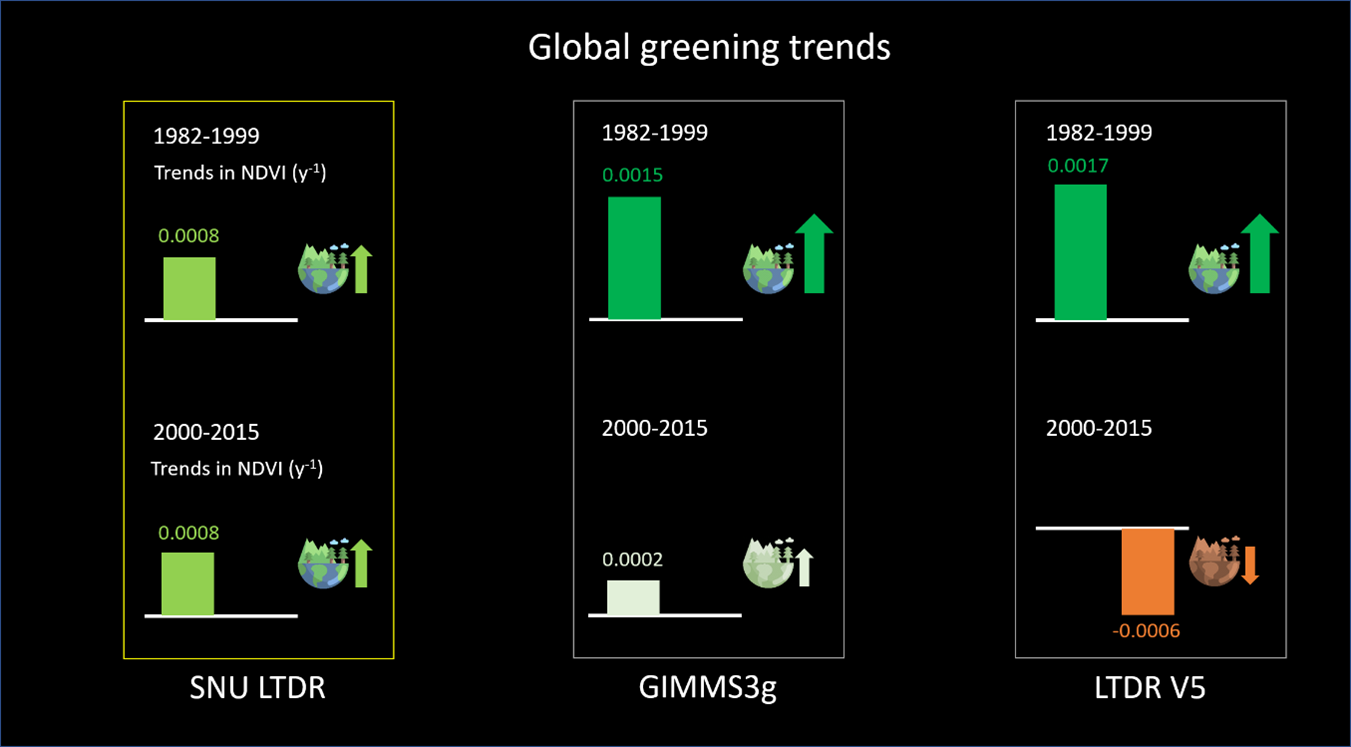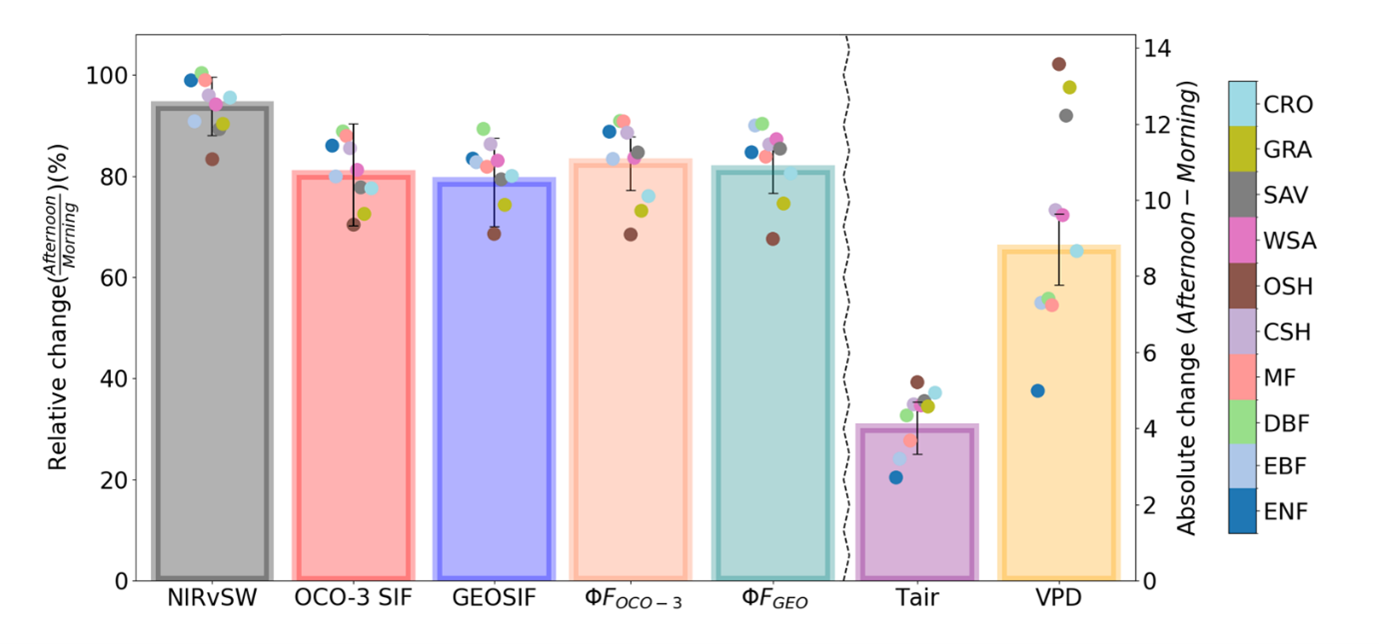Sungchan Jeong is a member of the LEMONTREE team based at Seoul National University who recently led the publication of two insightful new articles on vegetation and ecosystem dynamics. The work demonstrates the successful cross-institutional collaboration of the LEMONTREE project, involving a number of team members from different partner institutions.
The new research, published in the journal Remote Sensing of the Environment, highlights how satellite remote sensing data can be used to comprehend vegetation dynamics from diurnal to interannual scales.
Persistent global greening over the last four decades using novel long-term vegetation index data with enhanced temporal consistency
The problem
The paper “Persistent global greening over the last four decades using novel long-term vegetation index data with enhanced temporal consistency” focuses on improving the temporal consistency of long-term vegetation index datasets. Advanced Very High-Resolution Radiometer (AVHRR) sensors on satellites produce some of the world’s longest data measurements on land surfaces and have been used to derive vegetation indexes, amongst other products. However, a number of studies have pointed out that there are issues with the AVHRR derived datasets including temporal inconsistencies, orbital shifting and incomplete harmonization with other satellite products.
Methods and Results
This study addressed residual temporal inconsistency in the LTDR V5 dataset through a three-step post-processing, which includes cross sensor-calibration between AVHRR sensors, orbital drifting correction among AVHRR sensors, and a machine-learning based harmonization with MODIS.
Each different processing level of spectral reflectance and vegetation index were comprehensively evaluated across the pseudo-invariant calibration sites (PICS). After a three-step post-processing was applied, the remaining temporal inconsistencies in the long-term datasets were substantially reduced.
The refined long-term normalized difference vegetation index (NDVI) and near-infrared reflectance of vegetation (NIRv) datasets showed a persistent global greening trend over the last four decades. This is in contrast with previous studies which have demonstrated a decline in global greening since 2000.

Figure 1: A comparison of the global greening trends extracted from the Seoul National University model (SNU LTDR), GIMMS3g and LTDR V5.
Conclusions
Improving temporal consistencies within datasets, therefore, are crucial to improving accuracy of vegetation index datasets allowing us to more accurately predict global vegetation trends, particularly in the context of climate change. Moving forward, this new dataset can help us better understand global vegetation dynamics.
GEOSIF: A continental-scale sub-daily reconstructed solar-induced fluorescence derived from OCO-3 and GK-2A over Eastern Asia and Oceania
The paper “A continental-scale sub-daily reconstructed solar-induced fluorescence derived from OCO-3 and GK-2A over Eastern Asia and Oceania” investigates a different satellite derived vegetation product, solar-induced chlorophyll fluorescence (SIF). Reconstructing SIF derived from new generation satellites could allow us to improve our understanding of sub-daily scale ecosystem dynamics.
Methods and Results
In this study, the authors used data from the Geostationary Korea Multi-Purpose Satellite-2A (GK-2A) to improve coverage in the dataset. By utilising the original SIF data from the Orbiting Carbon Observatory-3 (OCO-3) alongside the data from GK-2A allowed the authors to reconstruct the data at this sub-daily scale.
This study highlights an explainable diurnal SIF prediction model using SHAP values that go beyond accuracy metrics. Their results show a clear difference in feature importance under normal and high-temperature conditions.
The results highlight a depression in afternoon SIF across a number of ecosystems, with is consistent with the original observations derived from OCO-3. Furthermore, the authors demonstrated that there is a stronger relationship between vapour-pressure deficit with diurnal changes in SIF than there is with temperature.

Figure 2: Relative change between morning and afternoon in NIRvSW, OCO-3 SIF, GEOSIF, ΦFOCO-3, ΦFGEO, and shortwave radiation (SW). Absolute change between afternoon and morning and air temperature (Tair) and vapor pressure deficit (VPD). Each bar indicates the averaged values and error bar indicates 1 standard deviation. Colored dots indicate averaged values in each ecosystem. The units of Tair and VPD are °C and hPa, respectively. (Taken from Jeong et al. 2024, Figure 9).
Conclusions
Collectively, these papers provide vegetation products than can be used to assist in the investigation of ecosystem processes and to improve land surface models (LSMs). These findings support the use of new-generation satellite observations to reconstruct sub-daily SIF with improved temporal and spatial consistency. Using this approach, other aspects of ecosystem dynamics such as the carbon and water cycles could be investigated more robustly.
Remaining artefacts in long-term satellite remote sensing datasets have hindered a robust evaluation of land surface models. The novel refined global long-term vegetation products derived from these studies could be used for the evaluation of LSMs.
Further, reconstructed SIF data can be used to reveal the diurnal-ecosystem scale mechanisms of the terrestrial carbon-water-energy cycle, which helps to improve the modules in land surface models.
To read the full version of both of these papers see the citations and links below:
Jeong, S., Ryu, Y., Lian, X., Dechant, B., Liu, J., Kong, J., Choi, W., Fang, J., Lian, X., Gentine, P. 2024. GEOSIF: A continental-scale sub-daily reconstructed solar-induced fluorescence derived from OCO-3 and GK-2A over Eastern Asia and Oceania. Remote Sensing of Environment 311, 114284, https://doi.org/10.1016/j.rse.2024.114284
Jeong, S., Ryu, Y., Gentine, P., Lian, X., Fang, J., Li, X., Dechant, B., Kong, J., Choi, W., Jiang, C., Keenan, T.I., Harrison, S.P., Prentice, I.C. 2024 Persistent global greening over the last four decades using novel long-term vegetation index data with enhanced temporal consistency. Remote Sensing of Environment 311, 114282, https://doi.org/10.1016/j.rse.2024.114282
By Sungchan Jeong and Sophia Cain
